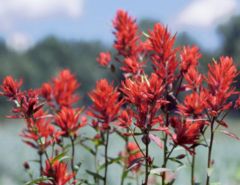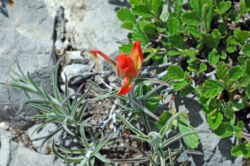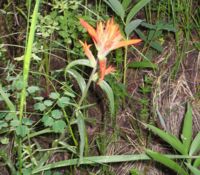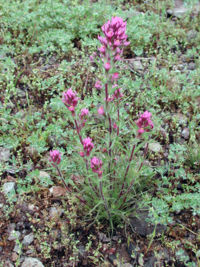Castilleja: Difference between revisions
No edit summary |
No edit summary |
||
| Line 1: | Line 1: | ||
{{Inc| | |||
Castilleja (a Spanish botanist, D. Castillejo). Scrophulariaceae. Painted-cup. Herbs with showy bracts in a terminal head or spike, sometimes cultivated. | |||
Flowers small, solitary, in terminal gaudy-bracted spikes; corolla tubular, sometimes flattened laterally, 2-lipped; lower lip smaller, more or less 3-toothed; stamens 4: lvs. alternate, entire or cut—Upwards of 3O species in U. S. and Mex., and 1 in N. Asia. Castillejas are little known in gardens. They are more or less root-parasitic. | |||
}} | |||
{{Taxobox | {{Taxobox | ||
| color = lightgreen | | color = lightgreen | ||
Revision as of 06:56, 16 June 2009
| Standard Cyclopedia of Horticulture |
|---|
|
Castilleja (a Spanish botanist, D. Castillejo). Scrophulariaceae. Painted-cup. Herbs with showy bracts in a terminal head or spike, sometimes cultivated. Flowers small, solitary, in terminal gaudy-bracted spikes; corolla tubular, sometimes flattened laterally, 2-lipped; lower lip smaller, more or less 3-toothed; stamens 4: lvs. alternate, entire or cut—Upwards of 3O species in U. S. and Mex., and 1 in N. Asia. Castillejas are little known in gardens. They are more or less root-parasitic.
The above text is from the Standard Cyclopedia of Horticulture. It may be out of date, but still contains valuable and interesting information which can be incorporated into the remainder of the article. Click on "Collapse" in the header to hide this text. |
| Castilleja {{{status}}} Fossil range: {{{fossil_range}}}
| ||||||||||||||||||||||||||||||||||||||||||||||||||||||||||||||||||
|---|---|---|---|---|---|---|---|---|---|---|---|---|---|---|---|---|---|---|---|---|---|---|---|---|---|---|---|---|---|---|---|---|---|---|---|---|---|---|---|---|---|---|---|---|---|---|---|---|---|---|---|---|---|---|---|---|---|---|---|---|---|---|---|---|---|---|
 | ||||||||||||||||||||||||||||||||||||||||||||||||||||||||||||||||||
| Plant Info | ||||||||||||||||||||||||||||||||||||||||||||||||||||||||||||||||||
| ||||||||||||||||||||||||||||||||||||||||||||||||||||||||||||||||||
| Scientific classification | ||||||||||||||||||||||||||||||||||||||||||||||||||||||||||||||||||
| ||||||||||||||||||||||||||||||||||||||||||||||||||||||||||||||||||
| [[{{{diversity_link}}}|Diversity]] | ||||||||||||||||||||||||||||||||||||||||||||||||||||||||||||||||||
| {{{diversity}}} | ||||||||||||||||||||||||||||||||||||||||||||||||||||||||||||||||||
| Binomial name | ||||||||||||||||||||||||||||||||||||||||||||||||||||||||||||||||||
| {{{binomial}}} | ||||||||||||||||||||||||||||||||||||||||||||||||||||||||||||||||||
| Trinomial name | ||||||||||||||||||||||||||||||||||||||||||||||||||||||||||||||||||
| {{{trinomial}}} | ||||||||||||||||||||||||||||||||||||||||||||||||||||||||||||||||||
| Type Species | ||||||||||||||||||||||||||||||||||||||||||||||||||||||||||||||||||
| {{{type_species}}} | ||||||||||||||||||||||||||||||||||||||||||||||||||||||||||||||||||
| Species | ||||||||||||||||||||||||||||||||||||||||||||||||||||||||||||||||||
| About 200 species, including: | ||||||||||||||||||||||||||||||||||||||||||||||||||||||||||||||||||
| [[Image:{{{range_map}}}|{{{range_map_width}}}|]] | ||||||||||||||||||||||||||||||||||||||||||||||||||||||||||||||||||
| Synonyms | ||||||||||||||||||||||||||||||||||||||||||||||||||||||||||||||||||
| {{{synonyms}}} |
Castilleja is a genus of about 200 species of annual and perennial herbaceous plants native to the west of the Americas from Alaska south to the Andes, as well as northeast Asia. Formerly classified in the family Scrophulariaceae, they have recently been relegated to the family Orobanchaceae as a consequence of molecular systematics research (see Angiosperm Phylogeny Group). They are commonly known as Indian paintbrush or Prairie-fire. They are semi-parasitic on the roots of grasses.
Castilleja species are used as food plants by the larvae of some Lepidoptera species including Schinia cupes (which has been recorded on C. exserta) and Schinia pulchripennis (which feeds exclusively on C. exserta). Also checkerspot butterflies such as Euphydryas.
One of the species of this genus, Indian paintbrush (Castilleja linariaefolia [1]) was adopted on January 31, 1917 as the state flower of Wyoming.



References
External links
Native Plant Information Network: Listing of species in the Castilleja genus.
Jepson Manual - taxonomic description of the genus.